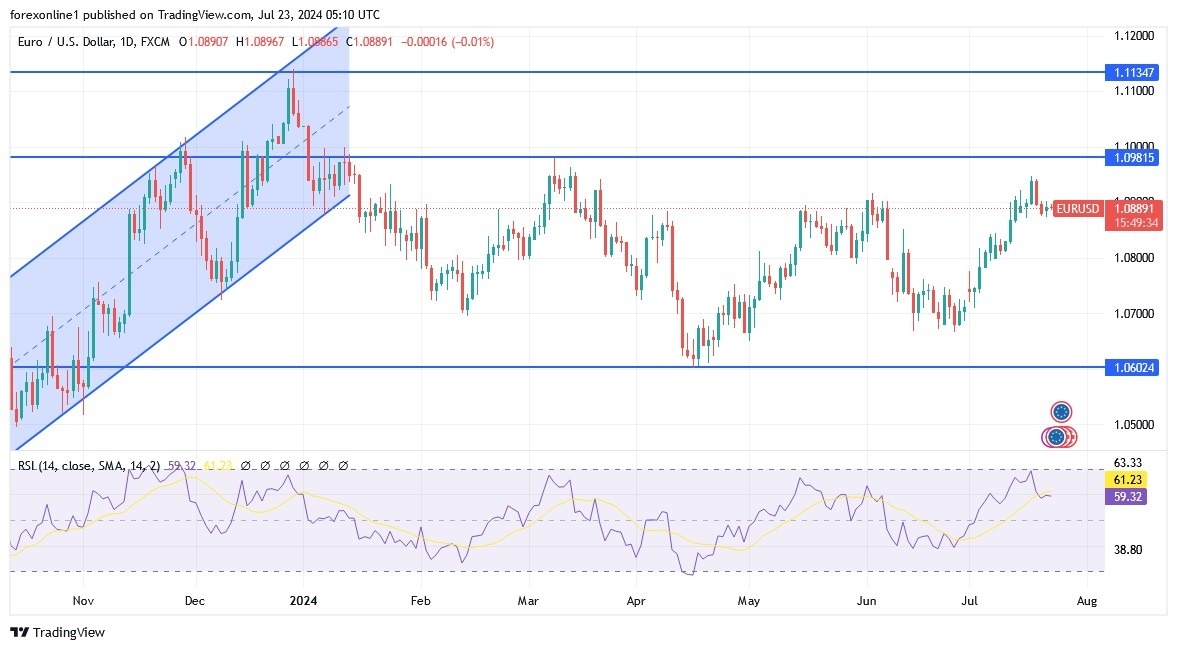- At the start of this week’s trading, the EUR/USD exchange rate remained stable around 1.0885, retreating from last week's four-month high of 1.0940.
- Despite the decline, the EUR/USD stayed stable even as the US dollar weakened following President Joe Biden’s decision to withdraw from the 2024 elections.
- Investors are now assessing the impact of this on financial markets and global monetary policy.
Recently, the European Central Bank (ECB) left its policy unchanged, with President Christine Lagarde stating that the next decision on September 12 is "wide open." This week, preliminary Purchasing Managers' Index (PMI) data for July for the Eurozone, Germany, and France will be released, with expectations of slower contraction in manufacturing and further expansion in the services sector. Additionally, consumer confidence in the Eurozone is expected to reach its highest level since February 2022. In Germany, both the GfK Consumer Climate Index and the Ifo Business Climate Index are anticipated to show improvement.
According to trading, European bond yields are falling. According to online trading platforms, the yield on 10-year German bonds dropped to around 2.46%, tracking a decline in US Treasury yields as traders digest the political situation in the US and its potential implications for the November elections and the economic outlook.
For his part, President Joe Biden ended his re-election bid and endorsed Vice President Kamala Harris as the Democratic Party’s candidate, but Donald Trump continues to lead the presidential race. Meanwhile, traders continue to bet that the European Central Bank will cut interest rates in September, although President Christine Lagarde said that the September interest rate decision is “wide open.” Recently, the European Central Bank left interest rates steady in July as expected and declined to give ground on the next move, saying it remained data dependent. Furthermore, Eurozone inflation fell to 2.5% in June but held steady at 4.1% for services.
Top Forex Brokers
EUR/USD Signals for the Days Ahead:
The euro could recover this week, dominated by US politics, Eurozone PMIs, and the US Personal Consumption Expenditures (PCE) inflation index. However, one analyst warns that the recent decline might indicate that the EUR/USD is caught in a classic “bull trap,” suggesting further weakness ahead. Some key fundamental developments to consider include Biden’s withdrawal from the November elections.
The “Trump trade” – widely seen as supportive of the US dollar – could be on the back foot after Biden’s announcement on Sunday. His replacement on the ticket is likely to be Vice President Kamala Harris, who polls suggest has a better chance of beating Trump. Overall, any positive USD flows linked to Trump’s presidency could be reversed if his chances of winning decline from here. (See where over 30 investment banks expect the EUR/USD to be by September and year-end.)
Currently, sentiment is dominating the forex markets, with last week’s global IT outage worrying markets and prompting investors to buy “safe haven” dollars at the expense of the euro. With the glitch fixed, we could see some improvement in investor sentiment that could support the EUR/USD once again.
EUR/USD Technical analysis and forecast:
Based on the daily chart attached, bulls are still looking for further stimulus to push EUR/USD towards the psychological resistance of 1.1000, which has often been cited as crucial to further upside momentum. Conversely, over the same timeframe, the 1.0820 and 1.0765 support levels remain a threat to the current upside. The Euro is not expecting any important economic data today, and from the United States, the number of existing US home sales and the Richmond manufacturing index will be announced. Additionally, any signals from central bank officials and the US election path will be watched closely.
Ready to trade our Forex daily analysis and predictions? Here's a list of regulated forex brokers to choose from

